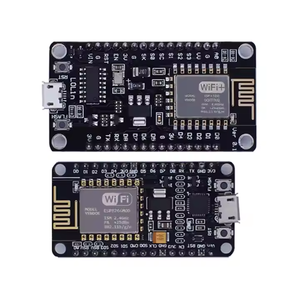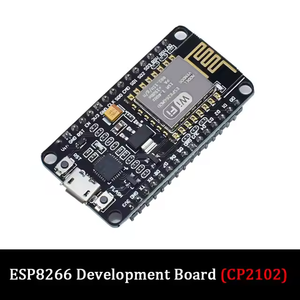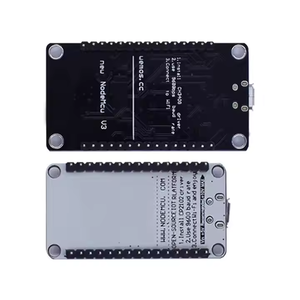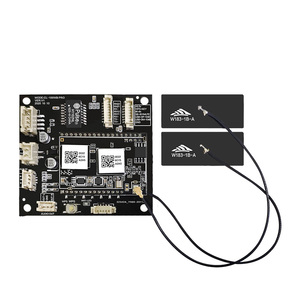Types of wifi audio receiver modules
A wifi audio receiver module is a device that connects to a speaker or sound system to enable wireless audio streaming. It receives audio signals via Wi-Fi and sends them to the connected speaker. There are two primary types of wifi audio receiver modules:
- DIY Wi-Fi Audio Receiver Module
A DIY wifi audio receiver module is a product that manufacturers have designed for integration into audio devices such as speakers, home audio systems, or headphones. It enables these devices to receive audio content wirelessly over Wi-Fi networks. DIY modules often come with software or firmware that handles the Wi-Fi connectivity and audio streaming protocols. They can be embedded within the circuitry of the target audio device, allowing the device to connect to a Wi-Fi network and receive audio streams directly from compatible sources like smartphones, tablets, or streaming services.
DIY wifi audio receiver modules provide manufacturers with a convenient way to add wireless audio capabilities to their products without having to develop complex networking and streaming functionality from scratch. By using a pre-built module, manufacturers can reduce development time and costs while offering customers the ability to stream audio content over Wi-Fi.
- Pre-Built Wi-Fi Audio Receiver
A pre-built wifi audio receiver is a standalone device that connects to an existing audio system, such as speakers or a home theater setup. It enables wireless audio streaming by receiving audio signals over Wi-Fi networks and transmitting them to the connected audio equipment. These devices are typically compact and easy to install, making them a convenient solution for adding wireless audio capabilities to traditional wired setups.
Depending on the specific device, pre-built models may support various streaming protocols and audio formats. They can work with popular streaming services and apps, allowing users to access a wide range of online content. Some pre-built wifi audio receivers also support multi-room audio setups, enabling synchronized audio playback across multiple rooms or speakers.
Both DIY modules and pre-built receivers offer distinct advantages depending on the user's needs and technical expertise. DIY modules are ideal for manufacturers looking to integrate wireless audio functionality into their audio products, while pre-built receivers provide consumers with a simple way to upgrade their existing audio setups for wireless streaming.
Features and Functions
There are many useful features and functions of wifi audio receiver modules. They make listening to music more enjoyable and convenient. Some of the primary features and their functions include the following:
- Wireless connectivity: One of the most important features of a wifi audio module is its wireless connectivity. This enables it to connect to different devices without the need for a cable.
- Multi-room audio streaming: Certain wifi audio modules can stream audio to different rooms. This is great for people who like to listen to music in the whole house.
- Music streaming: Wifi audio modules have music apps that enable users to listen to music from their devices. They can also listen to music from different streaming services.
- Voice control: Some wifi audio receiver modules have voice control functions. This enables users to use voice commands to control the music being played.
- Multimedia support: Some wifi audio receiver modules support multimedia. This means that they can receive audio from devices like phones or tablets.
- Smart home integration: Some wifi audio receiver modules can integrate with smart home devices. This enables the user to control the audio using other smart home devices.
Scenarios of wifi audio receiver module
Users can find various applications for the wifi audio receiver. Here are some of the most common ones:
- Home audio streaming: The module can connect to a home audio system to stream music from online platforms or devices wirelessly. Users can listen to music from any part of the house without worrying about tangled cables.
- Multi-room audio: Users can use multiple wifi audio modules to stream music simultaneously in different rooms. This will allow them to enjoy the same song throughout the house or play different tunes in each room. This is a good idea for parties or when a user wants to customize their listening experience.
- Car audio integration: Users can retrofit their cars with wifi audio receiver modules to upgrade their audio systems. This will allow users to stream music from their smartphones while driving without having to fiddle with cables or CDs.
- Public address systems: The wifi audio module receiver can transmit audio signals wirelessly in places like schools, airports, and train stations. This helps to ensure that important announcements can be heard clearly throughout the area.
- Outdoor entertainment: Because the wifi audio receiver is portable and can be used outside, users can use it at picnics, pool parties, or barbecues. Users can connect their smartphones to the receiver and play music for everyone to enjoy.
- Commercial applications: Businesses can use the wifi audio receiver to stream music in stores, restaurants, or offices. This can create a pleasant atmosphere for customers and employees.
- Home theater systems: Users can connect the wifi audio receiver to a home theater system to stream audio from smart TVs, gaming consoles, or Blu-ray players. This will provide an immersive audio experience without the limitations of cable connections.
- Wireless headphones: If the wifi audio receiver has a headphone jack or supports Bluetooth, users can connect wireless headphones to enjoy music privately without disturbing others around them.
- Recording studios: Studios can use the wifi audio receiver to monitor audio wirelessly from different parts of the studio. This can make it easier to produce music and ensure that everything sounds great.
How to Choose a Wifi Audio Receiver Module
When purchasing a WiFi audio receiver module, it's important to know the features that make the product stand out. Buyers who plan to resell the product should research the market to determine what customers are looking for.
- Transmitter and receiver: Some WiFi audio receiver modules can transmit and receive audio signals. If the customers are looking for a WiFi audio receiver module that will enable streaming from a phone to a home speaker, this type of device can be helpful.
- Range: Consider a WiFi audio receiver module with an excellent range that will provide seamless streaming experience. Customers may not want to be disappointed with network connections in their homes.
- Audio quality: Business buyers should look for a WiFi audio receiver module that has features to improve sound quality. Customers will want to enjoy music or podcasts without any distortion. Features like multiroom audio, audio codecs, and digital to analog conversion can help to enhance the listening experience.
- Compatibility: Buyers should consider a WiFi audio receiver module that can connect to various audio sources. Choosing a device that can work with a wide range of audio content will appeal to many customers. Look for one that can connect to streaming services, home entertainment, and mobile devices.
- Set up and control: Consider a WiFi audio receiver module that is easy to install and use. Buyers should also look for a device with a user-friendly mobile app. Apps make it easy to control the audio settings such as volume and playback. Some WiFi audio receiver modules have voice control features, allowing users to control the audio with voice commands.
Q&A
Q1. What is the range of Wi-Fi audio receiver modules?
A1. The range of a Wi-Fi audio receiver module varies depending on its design and other factors. However, on a typical home network, the range is around 150 feet indoors and around 300 feet outdoors.
Q2. Which is better, a Wi-Fi or Bluetooth audio receiver?
A2. A Wi-Fi receiver is often preferred over a Bluetooth receiver as it has a longer range. Bluetooth devices generally only work well within 33 feet of each other, whereas Wi-Fi devices can work up to 300 feet apart. This makes Wi-Fi more convenient for larger homes or office spaces.
Q3. Can I use a Wi-Fi audio receiver module without Wi-Fi?
A3. No, a Wi-Fi audio receiver module cannot be used if there is no Wi-Fi as it requires a wireless network to function. It will not work without the wireless network.
Q4. Do Wi-Fi audio receiver modules have an Ethernet port?
A4. Some Wi-Fi audio receiver modules have an Ethernet port, while others do not. It depends on the model. The Ethernet port is used to connect to a wired network if Wi-Fi is not available. If the Wi-Fi module does have an Ethernet port, it will be clearly stated in the product specifications.















































































































































































